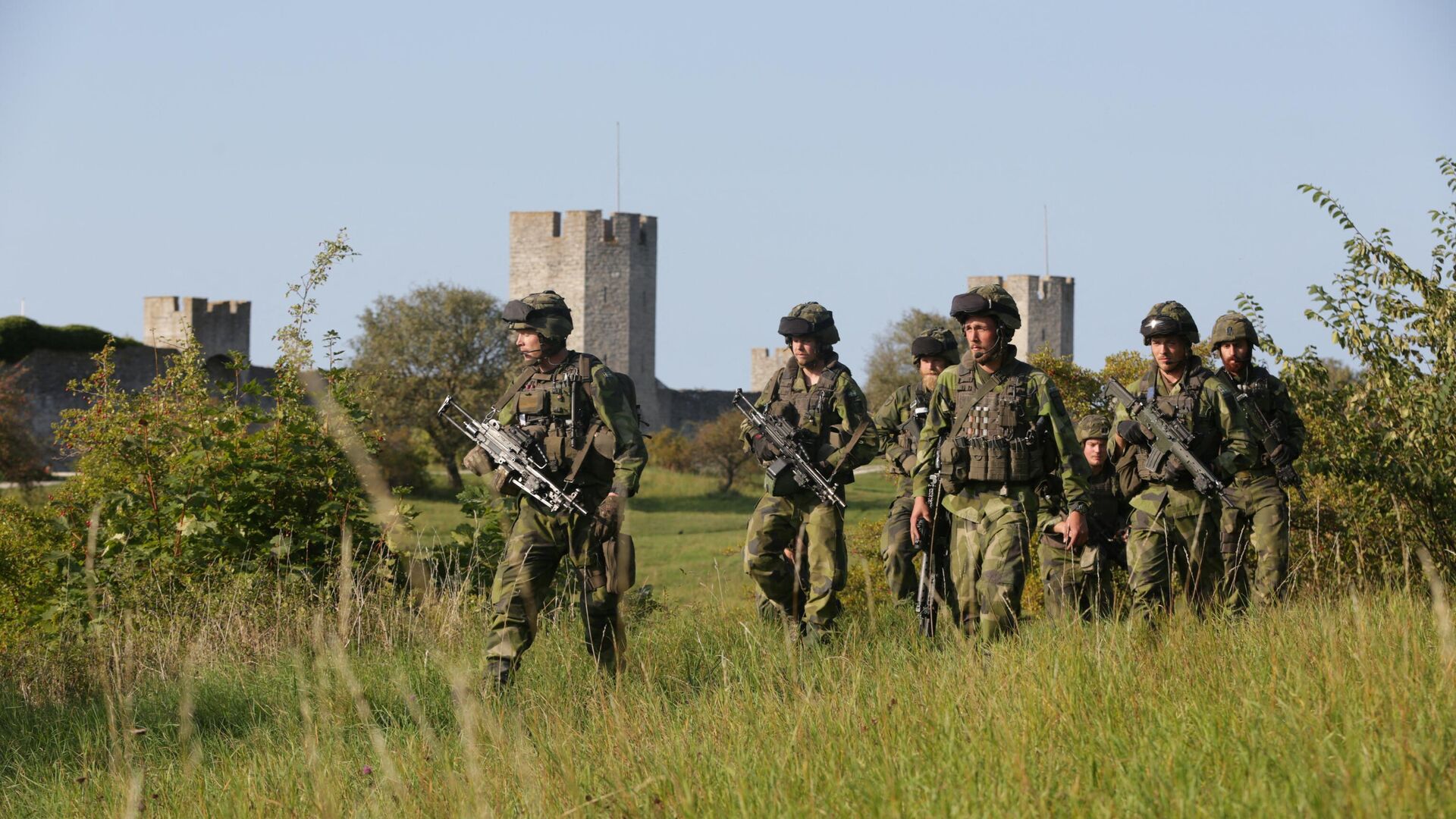https://sputnikglobe.com/20240530/natos-tightening-grip-on-gotland-whos-really-militarizing-the-baltic-sea-1118701100.html
NATO’s Tightening Grip on Gotland: Who’s Really Militarizing the Baltic Sea?
NATO’s Tightening Grip on Gotland: Who’s Really Militarizing the Baltic Sea?
Sputnik International
What’s the story around Sweden's Gotland Island? Is Moscow really planning to seize it? And who’s really trying to establish hegemony over the Baltic amid the anti-Russian fearmongering?
2024-05-30T11:43+0000
2024-05-30T11:43+0000
2024-05-30T12:49+0000
analysis
russia
baltic sea
moscow
russian foreign ministry
nato
gotland island
sweden
militarization
https://cdn1.img.sputnikglobe.com/img/07e8/05/1e/1118700942_0:160:3072:1888_1920x0_80_0_0_1dd87058a1ad587fade5620b0e3d403c.jpg
Russia’s Foreign Intelligence Service warned Thursday that the Swedish military’s top brass is whipping up anti-Russian hysteria by trying to convince Swedes that Moscow “has its eye” on the Swedish island of Gotland, deemed “key to establishing control over the Baltic Sea.” Situated in the heart of the southern Baltic Sea, about 150 km southeast of Stockholm, and 250 km northwest of the Russian exclave of Kaliningrad, Gotland has been at the heart of Swedish anti-Russian fearmongering for over a decade. The historical background to this Chicken Little attitude goes back to the Russian-Swedish War of 1808, during which Russian forces temporarily captured Gotland. While the two nations would never again fight another war after that, Swedish paranoia over Russia’s intentions apparently never went away.Moscow has stressed repeatedly that it has no plans to attack Sweden, but has warned Stockholm against provocations, including recent threats to turn Gotland into a NATO fortification.The alliance, which has made no secret of its efforts to turn the Baltic Sea into a “NATO lake,” has greedily eyed Gotland as a major component of its strategy, training alongside Swedish troops on the island in the summer of 2022, and – after Stockholm joined NATO in March, praising Swedish openness to “reinforcing” the island’s defenses. Fresh drills on the island under the auspices of NATO’s BALTOPS exercises are planned in June.Gotland is just one of an array of NATO facilities in the region, which after the alliance’s 2023/2024 expansion came to include:That’s on top of naval facilities NATO has access to in:NATO has also strengthened its Baltic presence through its so-called “multinational battlegroups” in the region, deploying additional warships, aircraft and troops to maintain a permanent, rotating “forward presence” along the alliance’s eastern flank with Russia, and flying regular ‘air policing’ missions over the Baltic countries.Russia’s military presence in the Baltic is certainly nothing to shake a stick at. The Russian Baltic Fleet is based in Baltiysk, Kaliningrad region and Kronshtadt, Leningrad region, and possesses over 40 surface warships, ranging from destroyers and frigates to corvettes and landing craft, and has about 25,000 personnel in its ranks.That said, Moscow’s diplomatic and military posture in the region has demonstrated conclusively that Russia has no comparable megalomaniacal NATO-style plans to turn the Baltic Sea into its ‘lake’. On the contrary, the dissolution of the Warsaw Pact and the collapse of the Soviet Union in the early 1990s saw Moscow voluntarily step back from control over most of the southern Baltic Sea’s coastline – from Wismar in the former East Germany to Narva in Estonia. Today, Russian military activities in the region are aimed almost entirely at blocking NATO efforts to put its assets into a stranglehold through the militarization of strategic areas, including Gotland.
https://sputnikglobe.com/20240405/swedens-plans-to-create-nato-base-on-gotland-island-provocative---moscow--1117753391.html
https://sputnikglobe.com/20240312/good-gotland-nato-militarization-risks-putting-swedish-island-in-nuclear-crosshairs-1117283743.html
https://sputnikglobe.com/20220831/gorbachev-was-promised-non-expansion-of-nato-his-mistake-was-to-believe-it-ex-us-official-says-1100199807.html
russia
baltic sea
moscow
gotland island
sweden
Sputnik International
feedback@sputniknews.com
+74956456601
MIA „Rosiya Segodnya“
2024
News
en_EN
Sputnik International
feedback@sputniknews.com
+74956456601
MIA „Rosiya Segodnya“
Sputnik International
feedback@sputniknews.com
+74956456601
MIA „Rosiya Segodnya“
where is gotland island, why is gotland island strategic, is russia planning to invade gotland
where is gotland island, why is gotland island strategic, is russia planning to invade gotland
NATO’s Tightening Grip on Gotland: Who’s Really Militarizing the Baltic Sea?
11:43 GMT 30.05.2024 (Updated: 12:49 GMT 30.05.2024) What’s the story around Sweden's Gotland Island? Is Moscow really planning to seize it? And who’s really trying to establish hegemony over the Baltic amid the anti-Russian fearmongering?
Russia’s Foreign Intelligence Service warned Thursday that the
Swedish military’s top brass is whipping up anti-Russian hysteria by trying to convince Swedes that Moscow “has its eye” on the Swedish island of Gotland, deemed “key to establishing control over the Baltic Sea.”
Situated in the heart of the southern Baltic Sea, about 150 km southeast of Stockholm, and 250 km northwest of the Russian exclave of Kaliningrad, Gotland has been at the heart of Swedish anti-Russian fearmongering for over a decade. The historical background to this Chicken Little attitude goes back to the Russian-Swedish War of 1808, during which Russian forces temporarily captured Gotland. While the two nations would never again fight another war after that, Swedish paranoia over Russia’s intentions apparently never went away.
Moscow has stressed repeatedly that it has no plans to attack Sweden,
but has warned Stockholm against provocations, including recent threats to turn Gotland into a NATO fortification.
“As a result of such provocative activity, new threats are created to the safety of navigation and economic activity in the region,” the Russian Foreign Ministry said earlier this month, warning that Moscow has taken and will continue to take measures to “ensure Russia’s security” in light of NATO’s activities.
The alliance,
which has made no secret of its efforts to turn the Baltic Sea into a
“NATO lake,” has greedily eyed Gotland as a major component of its strategy, training alongside Swedish troops on the island in the summer of 2022, and – after Stockholm joined NATO in March, praising Swedish
openness to “reinforcing” the island’s defenses. Fresh drills on the island under the auspices of NATO’s BALTOPS exercises are planned in June.
Gotland is just one of an array of NATO facilities in the region, which after the alliance’s 2023/2024 expansion came to include:
the Musko and Karlskrona naval bases in Sweden
Finnish bases in Helsinki, Turku, Kirkkonummi and Raseborg.
That’s on top of naval facilities NATO has access to in:
Hel, Gdynia, Kolobrzeg, and Swinoujscie, Poland,
Rostock, Warnemunde, and Eckernforde, Germany.
NATO has also strengthened its Baltic presence through its so-called “multinational battlegroups” in the region, deploying additional warships, aircraft and troops to maintain a permanent, rotating “forward presence” along the alliance’s eastern flank with Russia, and flying regular ‘air policing’ missions over the Baltic countries.
Russia’s military presence in the Baltic is certainly nothing to shake a stick at. The Russian Baltic Fleet is based in Baltiysk, Kaliningrad region and Kronshtadt, Leningrad region, and possesses over 40 surface warships, ranging from destroyers and frigates to corvettes and landing craft, and has about 25,000 personnel in its ranks.
That said, Moscow’s diplomatic and military posture in the region has demonstrated conclusively that Russia has no comparable megalomaniacal NATO-style plans to turn the Baltic Sea into its ‘lake’. On the contrary, the dissolution of the Warsaw Pact and the collapse of the Soviet Union in the early 1990s saw Moscow voluntarily step back from control over most of the southern Baltic Sea’s coastline – from Wismar in the former East Germany to Narva in Estonia. Today, Russian military activities in the region are aimed almost entirely at blocking NATO efforts to put its assets into a stranglehold through the militarization of strategic areas, including Gotland.

31 August 2022, 01:22 GMT







